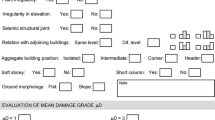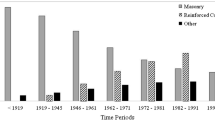Abstract
This paper addresses seismic vulnerability assessment at an urban scale and more specifically the capacity curves involved for building damage prediction. Standard capacity curves are a function of predefined building typology and are proposed in the Risk-UE LM2 method for computation of the corresponding damage grades. However, these capacity curves have been mainly developed for building stock of southern European cities and the accuracy of their application with different building features, such as the ones of cities of northern Europe should be assessed. A recent research project of seismic scenarios for the cities of Sion and Martigny in Switzerland provided the opportunity to check the capacity curves of Risk-UE LM2 method. Within the framework of this project, a detailed analysis was achieved for more than 500 buildings. These buildings were typical Swiss buildings and were composed of both unreinforced masonry buildings with stiff floors and reinforced concrete buildings. The construction drawings of each building were collected in order to have the most accurate information about their main structural characteristics. The typological classification that has been adopted was developed in a recent research project. Based on the individual features of the buildings, individual capacity curves were defined. Results of the seismic assessment applied to the 500 buildings compare very well with those obtained by using Risk-UE LM2 method for unreinforced masonry buildings with stiff floors. A slight improvement may be proposed for buildings with three stories through their introduction to the category of low-rise instead of mid-rise buildings. By contrast, accuracy for reinforced concrete buildings with shear walls is very poor. Damage prediction using related capacity curves of Risk-UE LM2 method does not correspond to reality. Prediction is too pessimistic and moreover damage grades increase with the height category (low-rise, mid-rise and high-rise) of these buildings which is in contradiction with the observed damages for this type of buildings. Improvements are proposed to increase the accuracy of the seismic vulnerability assessment for northern European building stock. For unreinforced masonry buildings, a slight modification of the limits of the height category of buildings using the ones defined for RC buildings improves the damage prediction. For reinforced concrete buildings with shear walls improved capacity curves derived from the typological curves of the specific typology C are proposed.

























Similar content being viewed by others
References
Benedetti D, Petrini V (1984) On seismic vulnerability of masonry buildings: proposal of an evaluation procedure. L’Industria delle Costruzioni 18:66–78 (in Italian)
Cattari S, Curti E, Giovinazzi S, Lagomarsino S, Parodi S, Penna A (2004) Un modello meccanico per l’analisi di vulnerabilità del costruito in muratura a scala urbana. In: Proceedings of XI Convegno Nazionale “L’ingegneria sismica in Italia”, Genova, Italy
Crowley H, Pinho R, Bommer JJ (2004) A probabilistic displacement-based vulnerability assessment procedure for earthquake loss estimation. Bull Earthq Eng 2(2):173–219
Dolce M, Masi A, Marino M, Vona M (2003) Earthquake damage scenarios of the building stock of Potenza (Southern Italy) including site effects. Bull Earthq Eng 1:115–140
Ergunay O, Gulkan P (1991) Seismic risk reduction and disaster management: national report of Turkey. In: Proceedings of workshop on seismic risk reduction and disaster management, Roma, Italy, November
Fajfar P (1999) Capacity spectrum method based on inelastic demand spectra. Earthq Eng Struct Dyn 28:979–993
FEMA 178 (1997) NEHRP handbook for the seismic evaluation of existing buildings. Federal Emergency Management Agency
Freeman SA (1998) The capacity spectrum method. In: Proceedings on 11th European conference on earthquake engineering. Paris
Fritsche S, Fäh D (2009) The 1946 magnitude 6.1 earthquake in the Valais: site-effects as contributor to the damage. Swiss J Geosci 102(3):423–439
GNDT (1993) Rischio sismico di edifici pubblici—Parte I: aspetti metodologici, Centro Servizi Quasco, Bologna. (in Italian)
Greifenhagen C, Lestuzzi P (2005) Static-cyclic tests on low reinforced concrete shear walls. Eng Struct 27(11):1703–1712
Grünthal G, Musson RMW, Schwarz J, Stucchi M (2001) European Macroseismic Scale 1998, EMS-98. Cahiers du Centre Européen de Géodynamique et de Séismologie, vol 19. Conseil de l’Europe, Luxembourg. ISBN 2-9599804-3-3
Guéguen P, Michel C, Le Corre L (2007) A simplified approach for vulnerability assessment in moderate-to-low seismic hazard regions: application to Grenoble (France). Bull Earthq Eng 5(3):467–490
HAZUS (1999) Earthquake loss estimation methodology—technical and user manuals, vol 1–3. Federal Emergency Management Agency (FEMA), National Institute of Building Sciences, Washington, DC
Kazantzidou-Firtinidou D, Bozzano C, Rouiller J-D, Lestuzzi P, Podestà S, Luchini C (2015) Evaluation expéditive de la vulnérabilité sismique du bâti des agglomérations de Sion et Martigny. Projet SEISMOVAL-Risk-UE-UniGEN. Rapport final. CREALP. (in French)
Lagomarsino S, Cattari S (2013) Seismic vulnerability of existing buildings: observational and mechanical approaches for application in urban areas—Chapter 1. In: Guéguen P (ed) Seismic vulnerability of structures, pp 1–62. ISTE Ltd and John Wiley and Sons
Lagomarsino S, Giovinazzi S (2006) Macroseismic and mechanical models for the vulnerability and damage assessment of current buildings. Bull Earthq Eng 4:415–443
Lang K, Bachmann H (2003) On the seismic vulnerability of existing unreinforced masonry buildings. J Earthq Eng 7(3):407–426
Lestuzzi P, Podestà S, Luchini C, Garofano A, Kazantzidou-Firtinidou D, Bozzano C, Bischof P, Haffter A (2016) Seismic vulnerability assessment at urban scale for two typical Swiss cities using Risk-UE methodology. Nat Hazards. doi:10.1007/s11069-016-2420-z
Liel AB, Haselton CB, Deierlein GG, Baker JW (2009) Incorporating modeling uncertainties in the assessment of seismic collapse risk of buildings. Struct Saf 31(2):197–211
Luchini C (2016). Development of displacement-based methods for seismic risk assessment of the existing building stock. Ph.D. thesis, University of Genova, Italy
Luchini C, Podestà S (2015) Sviluppo di modelli meccanici con approccio agli spostamenti per la valutazione della vulnerabilità sismica delle tipologie strutturali svizzere. In: Proceedings on of 16th Italian conference on earthquake engineering, L’Aquila, Italy. (in Italian)
Michel C, Lestuzzi P, Lacave C (2014) Simplified non-linear seismic displacement demand prediction for low period structures. Bull Earthq Eng 12(4):1563–1581
Milutinovic ZM, Trendafiloski GS (2003) An advanced approach for earthquake risk scenarios with applications to different European towns. WP-4: vulnerability of current buildings. Risk-UE Project, European Commission
Mouroux P, Le Brun B (2006) Presentation of RISK-UE Project. Bull Earthq Eng 4:323–339
Mouroux P, Bertrand E, Bour M, Le Brun B, Depinois S, Masure P, RISK-UE team (2004) The European RISK-UE Project: an advanced approach to earthquake risk scenarios. In: 13th world conference on earthquake engineering (WCEE), Vancouver, B.C., Canada, 1–6 August 2004, Paper No. 3329
Oliveira CS (2003) Seismic vulnerability of historical constructions: a contribution. Bull Earthq Eng 1(1):37–82
Onur T, Ventura CE, Liam Finn WD (2005) Regional seismic risk in British Columbia—damage and loss distribution in Victoria and Vancouver. Can J Civ Eng 32:361–371
Otani S (2000) Seismic vulnerability assessment methods for buildings in Japan. Earthq Eng Eng Seismol 2(2):47–56
Pagnini LC, Vicente RS, Lagomarsino S, Varum H (2011) A mechanical model for the seismic vulnerability assessment of old masonry buildings. Earthq Struct 2(1):25–42
Risk-UE (2003) An advanced approach to earthquake risk scenarios with applications to different European towns. Projet Européen, EVK4-CT-2000-00014
Roca A, Goula X, Susagna T, Chávez J, González M, Reinoso E (2006) A simplified method for vulnerability assessment of dwelling buildings and estimation of the damage scenarios in Catalonia (Spain). Bull Earthq Eng 4(2):141–158
Seismocare (1998). Seismocare computed aided reduction of seismic risk with application to existing cities, town planning and construction—directions to fill in the vulnerability form GNDT levels 1 and 2. European project Environment and Climate, 1994–1998. ENV4-CT97-0588
SIA 261 (2003, Swiss standard). Actions on structures, Swiss Society of Engineers and Architects (SIA), Zurich 2003
SIA 2018 (2004, Swiss standard). Vérification de la sécurité parasismique des bâtiments existants, Swiss Society of Engineers and Architects (SIA), Zurich, 2004. (in French)
Swiss Seismological Service (SED) at ETH Zurich (2015) Swiss National Probabilistic Seismic Hazard Assessment 2015. Zurich: Federal Institute of Technology. 23 May 2016 from http://www.seismo.ethz.ch/prod/Erdbebengefaehrdungsmodell_2015/index_EN
Ventura CE, Liam Finn WD, Onur T, Blanquera A, Rezai M (2005) Regional seismic risk in British Columbia—classification of buildings and development of damage probability functions. Can J Civ Eng 32:372–387
Acknowledgments
The investigations were founded by the canton of Valais, the cities of Sion and Martigny and the Centre de Recherche sur l’Environnement Alpin (CREALP). Authors are grateful to anonymous reviewers for the detailed reviews and comments that significantly improved the quality of the paper.
Author information
Authors and Affiliations
Corresponding author
Rights and permissions
About this article
Cite this article
Lestuzzi, P., Podestà, S., Luchini, C. et al. Validation and improvement of Risk-UE LM2 capacity curves for URM buildings with stiff floors and RC shear walls buildings. Bull Earthquake Eng 15, 1111–1134 (2017). https://doi.org/10.1007/s10518-016-9981-9
Received:
Accepted:
Published:
Issue Date:
DOI: https://doi.org/10.1007/s10518-016-9981-9




